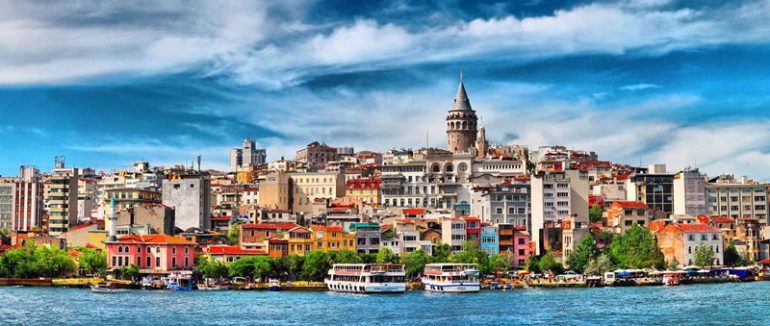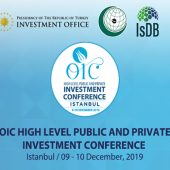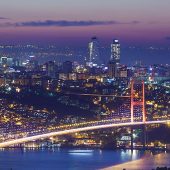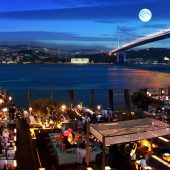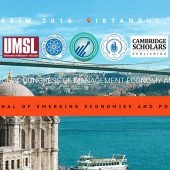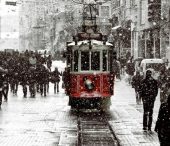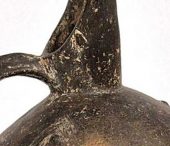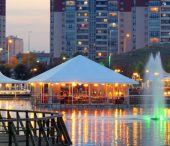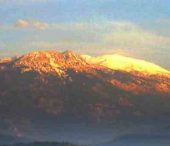Istanbul is Europe's most populous city (the world's 3rd largest city proper and 20th largest urban area) and Turkey's cultural and financial center. The city covers 27 districts of the Istanbul province. It is located on the Bosphorus Strait and encompasses the natural harbor known as the Golden Horn, in the northwest of the country. It extends both on the European (Thrace) and on the Asian (Anatolia) side of the Bosphorus, and is thereby the only metropolis in the world which is situated on two continents. In its long history, Istanbul served as the capital city of the Roman Empire (330–395), the East Roman (Byzantine) Empire (395–1204 and 1261–1453), the Latin Empire (1204–1261), and the Ottoman Empire (1453–1922). The city was chosen as joint European Capital of Culture for 2010. The historic areas of Istanbul were added to the UNESCO World Heritage List in 1985
ISTANBUL - Click for for detailed information
Names
Further information: Names of Istanbul
The modern Turkish name İstanbul can be attested, in a range of different variants, from as far back as the 10th century; it has been the common name for the city in normal Turkish speech since before the conquest of 1453. Etymologically, it derives from the Greek phrase "εἰς τὴν Πόλιν" or in the Aegean dialect "εἰς τὰν Πόλιν" (modern Greek "στην Πόλι"), which means "in the city", "to the city" or "downtown".
Byzantium is the first known name of the city. When Roman emperor Constantine I (Constantine the Great) made the city the new eastern capital of the Roman Empire on May 11, 330, he conferred on it the name Nova Roma ("New Rome"). Constantinople ("City of Constantine") was the name by which the city became instead more widely known. It is first attested in official use under emperor Theodosius II (408–450). It remained the principal official name of the city throughout the Byzantine period, and the most common name used for it in the West until the early 20th century.
The city has also been nicknamed "The City on Seven Hills" because the historic peninsula, the oldest part of the city, was built on seven hills (just like Rome), each of which bears a historic mosque. The hills are represented in the city's emblem with seven triangles, above which rise four minarets. Two of many other old nicknames of Istanbul are Vasilevousa Polis (the Queen of Cities), which rose from the city's importance and wealth throughout the Middle Ages; and Dersaadet, originally Der-i Saadet (the Door to Happiness) which was first used towards the end of 19th century and is still remembered today.
With the Turkish Postal Service Law of March 28, 1930, the Turkish authorities officially requested foreigners to adopt Istanbul as the sole name also in their own languages.
History
“ If the Earth were a single state, Istanbul would be its capital. ”
—Napoleon Bonaparte
The first human settlement in Istanbul, the Fikirtepe mound on the Anatolian side, is from the Copper Age period, with artifacts dating from 5500–3500 BC. A port settlement dating back to the Phoenicians has been discovered in nearby Kadıköy (Chalcedon). Cape Moda in Chalcedon was the first location which the Greek settlers of Megara chose to colonize in 685 BC, prior to colonising Byzantion on the European side of the Bosphorus under the command of King Byzas in 667 BC. Byzantion was established on the site of an ancient port settlement named Lygos, founded by Thracian tribes between the 13th and 11th centuries BC, along with the neighbouring Semistra, of which Plinius had mentioned in his historical accounts. Only a few walls and substructures belonging to Lygos have survived to date, near the Seraglio Point (Turkish: Sarayburnu), where the famous Topkapı Palace now stands. During the period of Byzantion, the Acropolis used to stand where the Topkapı Palace stands today.
After siding with Pescennius Niger against the victorious Roman emperor Septimius Severus, the city was besieged by the Romans and suffered extensive damage in 196 AD. Byzantium was rebuilt by Severus and quickly regained its previous prosperity, being temporarily renamed as Augusta Antonina by the emperor, in honor of his son.
The location of Byzantium attracted Constantine I in 324 after a prophetic dream was said to have identified the location of the city; but the true reason behind this prophecy was probably Constantine's final victory over Licinius at the Battle of Chrysopolis (Üsküdar) on the Bosphorus, on September 18, 324, which ended the civil war between the Roman Co-Emperors, and brought an end to the final vestiges of the Tetrarchy system, during which Nicomedia (present-day İzmit, 100 km (62 mi) east of Istanbul) was the most senior Roman capital city. Byzantium (now renamed as Nova Roma which eventually became Constantinopolis, i.e. "The City of Constantine") was officially proclaimed the new capital of the Roman Empire six years later, in 330. Following the death of Theodosius I in 395 and the permanent partition of the Roman Empire between his two sons, Constantinople became the capital of the Eastern Roman (Byzantine) Empire. As well as being the centre of an imperial dynasty, the unique position of Constantinople at the centre of two continents made the city a magnet for international commerce, culture and diplomacy. The Byzantine Empire was distinctly Greek in culture and became the centre of Greek Orthodox Christianity, while its capital was adorned with many magnificent churches, including the Hagia Sophia, once the world's largest cathedral. The seat of the Patriarch of Constantinople, spiritual leader of the Eastern Orthodox Church, still remains in the Fener (Greek: Phanar) district of Istanbul.
In 1204, the Fourth Crusade was launched to capture Jerusalem, but had instead turned on Constantinople, which was sacked and desecrated. The city subsequently became the centre of the Catholic Latin Empire, created by the crusaders to replace the Orthodox Byzantine Empire, which was divided into a number of splinter states, of which the Empire of Nicaea was to recapture Constantinople in 1261 under the command of Michael VIII Palaeologus.
In the last decades of the Byzantine Empire, the city had decayed as the Byzantine state became increasingly isolated and financially bankrupt, its population had dwindled to some thirty or forty thousand people whilst large sections remained uninhabited. Due to the ever increasing inward turn the Byzantines took, many facets of their surrounding empire were now falling apart, leaving them vulnerable to attack. Ottoman Turks began a strategy by which they took selected towns and smaller cities over time, enveloping Bursa in 1326, Nicomedia in 1337, Gallipoli in 1354, and finally Adrianople in 1362. This essentially cut off Constantinople from its main supply routes, strangling it slowly.
On May 29, 1453, Sultan Mehmed II "the Conqueror" captured Constantinople after a 53-day siege and proclaimed that the city was now the new capital of his Ottoman Empire. Sultan Mehmed's first duty was to rejuvenate the city economically, creating the Grand Bazaar and inviting the fleeing Orthodox and Catholic inhabitants to return. Captured prisoners were freed to settle in the city whilst provincial governors in Rumelia and Anatolia were ordered to send four thousand families to settle in the city, whether Muslim, Christian or Jew, to form a unique cosmopolitan society. The Sultan also endowed the city with various architectural monuments, including the Topkapı Palace and the Eyüp Sultan Mosque. Religious foundations were established to fund the construction of grand imperial mosques (such as the Fatih Mosque which was built on the spot where the Church of the Holy Apostles once stood), adjoined by their associated schools, hospitals and public baths. Suleiman the Magnificent's reign of the Ottoman Empire from 1520 to 1566 was a period of great artistic and architectural achievements. The famous architect Sinan designed many mosques and other grand buildings in the city, while Ottoman arts of ceramics and calligraphy also flourished.
When the Republic of Turkey was founded in 1923 by Mustafa Kemal Atatürk, the capital was moved from Istanbul to Ankara. In the early years of the republic, Istanbul was overlooked in favour of the new capital Ankara. However, in the 1950s, Istanbul underwent great structural change, as new roads and factories were constructed throughout the city. Wide modern boulevards, avenues and public squares were built in Istanbul, sometimes at the expense of the demolition of many historical buildings. During the 1970s, the population of Istanbul began to rapidly increase as people from Anatolia migrated to the city in order to find employment in the many new factories that were constructed at the outskirts of the city. This sudden sharp increase in the population caused a rapid rise in housing development, and many previously outlying villages became engulfed into the greater metropolis of Istanbul. Illegal construction, combined with corner-cutting methods, have accounted for the reason why 65% of all of the buildings in Istanbul are not up to standard. The concerns have increased due to the serious nature of the Izmit earthquake of 1999
Geography
Istanbul and the BosporusIstanbul is located in the north-west Marmara Region of Turkey. It encloses the southern Bosphorus which places the city on two continents—the western portion of Istanbul is in Europe, while the eastern portion is in Asia. The city boundaries cover a surface area of 1,539 square kilometres (594 sq mi), while the metropolitan region, or the Province of Istanbul, covers 6,220 square kilometres (2,402 sq mi).
Climate
The city has a Mediterranean climate with hot and humid summers; and cool, rainy and often snowy winters. Humidity is generally rather high which can make temperatures feel much warmer or colder than they actually are. Yearly precipitation for Istanbul averages 640 millimetres (25.2 in). Snowfall is quite common, snowing for a week or two during the winter season, but it can be heavy once it snows. It is most likely to occur between the months of December and March. The summer months between June and September bring average daytime temperatures of 28 °C (82 °F). The warmest month is July with an average temperature of 23.3 °C (74 °F), the coldest is January with 5.6 °C (42 °F). The weather becomes slightly cooler as one moves toward eastern Istanbul. Summer is by far the driest season, although there is no real summer drought such as those occurring at Mediterranean climates or in the arid interior of Turkey. The city is quite windy, having an average wind speed of 17 km/h (11 mph).
Geology
Istanbul is situated near the North Anatolian fault line, which runs from northern Anatolia to the Marmara Sea. Two tectonic plates, the African and the Eurasian, push against each other here. This fault line has been responsible for several deadly earthquakes in the region throughout history. In 1509 a catastrophic earthquake caused a tsunami which broke over the sea-walls of the city, destroying over 100 mosques and killing 10,000 people. In 1766 the Eyüp Sultan Mosque was largely destroyed. The 1894 earthquake caused the collapse of many parts of the Grand Bazaar. A devastating earthquake in August 1999, with its epicenter in nearby Kocaeli, left 18,000 dead and many more homeless. In all of these earthquakes, the devastating effects are a result of the close settlement and poor construction of buildings. Seismologists predict another earthquake, possibly measuring magnitude 7.0, occurring before 2025
Architecture
Main article: Architecture of Istanbul
Throughout its long history, Istanbul has acquired a reputation for being a cultural and ethnic melting pot. As a result, there are many historical mosques, churches, synagogues, palaces, castles and towers to visit in the city. Some of these historical structures, which draw millions to the city every year, reflect the heart and soul of Istanbul.
The famous Maiden's (Leander's) Tower, one of the symbols of Istanbul, was originally built by the ancient Athenian general Alcibiades in 408 BC to control the movements of the Persian ships in the Bosphorus strait. Back then it was located between the cities of Byzantion and Chrysopolis. The tower was later enlarged and rebuilt as a fortress by the Byzantine emperor Alexius Comnenus in 1110, and was rebuilt and restored several times by the Ottoman Turks, most significantly in 1509 and 1763.
The most important monuments of Roman architecture in the city include the Column of Constantine (Turkish: Çemberlitaş), which was erected in 330 by Constantine the Great for marking the declaration of the new capital city of the Roman Empire and contained several fragments of the True Cross and other artifacts belonging to Jesus Christ and Virgin Mary, the Mazulkemer Aqueduct, the Valens Aqueduct, the Column of the Goths at the Seraglio Point, the Milion which served for calculating the distances between Constantinople and other cities of the Roman Empire, and the Hippodrome of Constantinople which was built following the model of the Circus Maximus in Rome. Construction of the Walls of Constantinople began under Constantine the Great, who enlarged the previously existing walls of Byzantium in order to defend the new Roman capital city which quickly grew following its proclamation as Nova Roma. A new set of walls was built further west during the reign of Theodosius II, and rebuilt after an earthquake in 447 in their current shape.
The early Byzantine architecture followed the classical Roman model of domes and arches, but further improved these architectural concepts, as evidenced with the Hagia Sophia, which is the largest structure on Sultanahmet Square in the Eminönü district. The Hagia Sophia was designed by Isidorus and Anthemius as the third church to rise on this location, between 532 and 537, following the Nika riots (532) during which the second church was destroyed (the first church, known as the Megala Ekklessia ("Great Church") was inaugurated by Constantius II in 360; the second church was inaugurated by Theodosius II in 405, while the third and current one was inaugurated by Justinian in 537). The Church of Saints Sergius and Bacchus (commonly known as the Little Hagia Sophia), which was the first church built by Justinian in Constantinople and edificed between 527 and 536, had earlier signaled such an improvement in the design of domed buildings, which require complex solutions for carrying the structure. The present-day Hagia Irene (which was originally built by Constantine in the 4th century, but was later enlarged by Justinian in the 6th century) and the Basilica Cistern are also from this period.
The most important churches which were built after the Byzantines recovered Constantinople from the Latin Crusaders in 1261 include the Pammakaristos Church and Chora Church. Also in this period, the Genoese Podestà of Galata, Montano de Marinis, built the Palazzo del Comune (1314), a copy of the San Giorgio Palace in Genoa, which still stands in ruins on the back streets of Bankalar Caddesi in Galata, together with its adjacent buildings and numerous Genoese houses from the early 1300s. The Genoese also built the Galata Tower, which they named as Christea Turris (Tower of Christ), at the highest point of the citadel of Galata, in 1348.
The Ottoman Turks built the Anadoluhisarı on the Asian side of the Bosphorus in 1394, and the Rumelihisarı at the opposite (European) shore, in 1452, a year before the conquest of Constantinople. The main purpose of these castles, armed with the long range Balyemez (Faule Metze) cannons, was to block the sea traffic of the Bosphorus and prevent the support ships from the Genoese colonies on the Black Sea ports, such as Caffa, Sinop, and Amasra, from reaching Constantinople and helping the Byzantines during the Turkish siege of the city.
Following the Ottoman conquest of the city, Sultan Mehmed II initiated a wide scale reconstruction plan, which included the construction of grand buildings such as the Eyüp Sultan Mosque, Fatih Mosque, Topkapı Palace, the Grand Bazaar and the Yedikule (Seven Towers) Castle which guarded the main entrance gate of the city, the Porta Aurea (Golden Gate). In the centuries following Mehmed II, many new important buildings, such as the Süleymaniye Mosque, Sultanahmet Mosque, Yeni Mosque and numerous others were constructed. In the 18th and 19th centuries, traditional Ottoman architectural styles were gradually replaced by European styles, such as the Baroque style interiors of the Aynalıkavak Palace (1677–1679) and Nuruosmaniye Mosque (1748–1755, the first Baroque style mosque in the city, also famous for its Baroque fountain), and the 18th century Baroque additions to the Harem section of the Topkapı Palace. Following the Tanzimat reforms which effectively started Turkey's Europeanization process in 1839, new palaces and mosques were built in Neoclassical, Baroque and Rococo styles, or a mixture of all three, such as the Dolmabahçe Palace, Beylerbeyi Palace and Ortaköy (Mecidiye) Mosque.
Starting from the early 19th century, the areas around İstiklal Avenue were filled with grandiose embassy buildings belonging to prominent European states, and rows of European (mostly Neoclassical and later Art Nouveau) style buildings started to appear on both flanks of the avenue. Istanbul especially became a major center of the Art Nouveau movement in the late 19th and early 20th centuries, with famous architects of this style like Raimondo D'Aronco building many palaces and mansions in the city proper and on the Princes' Islands. His most important works in the city include several buildings of the Yıldız Palace complex, and the Botter House on İstiklal Avenue. The famous Camondo Stairs on Bankalar Caddesi (Banks Street) in Karaköy (Galata) is also a beautiful example of Art Nouveau architecture. Other important examples are the Hıdiv Kasrı (Khedive Palace) on the Asian side of the Bosphorus, Flora Han in Sirkeci, and Frej Apartmanı in the Şişhane quarter of Beyoğlu.
Urbanism
The urban landscape is constantly changing. In the Greek, Roman and Byzantine periods, the city was largely made up of the historic peninsula of Constantinople, with the citadel of Galata (also called Sykae or Pera) at north, and Chrysopolis (Üsküdar) and Chalcedon (Kadıköy) at east, across the Bosphorus. These were all independent cities back then. The present City of Istanbul can be considered the metropolitan area of old Constantinople, encompassing every single settlement around the original city, and expanding even further with the establishment of new neighbourhoods and districts since the 19th century.
Until the early 19th century, the city walls of Galata, the medieval Genoese citadel, used to stand. These Genoese fortifications, of which only the Galata Tower stands today, were demolished in the early 1800s to give way for a northwards expansion of the city, towards the neighbourhoods of Beşiktaş, Şişli, Nişantaşı, and beyond.
In the last decades, numerous tall structures were built around the city to accommodate a rapid growth in population. Surrounding towns were absorbed into Istanbul as the city rapidly expanded outwards. The tallest highrise office and residential buildings are mostly located in the northern areas of the European side, and especially in the business and shopping districts of Levent, Maslak, and Etiler which are situated between the Bosphorus Bridge and Fatih Sultan Mehmet Bridge. Levent and Etiler also have numerous upmarket shopping malls, like Kanyon, Metrocity, Akmerkez, Mayadrom and Mayadrom Uptown. The headquarters of Turkey's largest companies and banks are also located in this area.
Starting from the second half of the 20th century, the Asian side of Istanbul, which was originally a tranquil place full of seaside summer residences and elegant chalet mansions surrounded by lush and vast umbrella pine gardens, experienced a massive urban growth. The construction of the long, wide and elegant Bağdat Avenue, with its rows of upscale shops and restaurants, contributed much to the initial expansion in the area. The fact that these areas were largely empty until the 1960s also provided the chance for developing better infrastructure and a tidier urban planning when compared with most other residential areas in the city. But the real expansion of the Asian side came with the opening of Ankara Asfaltı, the Asian extension of the E5 highway, which is located to the north of Bağdat Avenue, parallel to the railway line. Another important factor in the recent growth of the Asian side of the city was migration from Anatolia. Today, more than 1/3 of the city's population live in the Asian side of Istanbul.
As a result of Istanbul's exponential growth during the second half of the 20th century, a significant portion of the city's outskirts consists of gecekondus, a Turkish word created in the 1940s meaning ‘built overnight’ and referring to the illegally constructed squatter buildings that comprise entire neighbourhoods and run rampant outside the historic centers of Turkey's largest cities, especially Istanbul, Ankara, İzmir, and Bursa. At present, some gecekondu areas are being gradually demolished and replaced by modern mass-housing compounds.
Organization
The mayor of Istanbul, currently Kadir Topbaş, serves as the prefect of the city, as well as governor of the province. Istanbul is a home rule city and municipal elections are mainly partisan. The metropolitan model of governance has been used with the establishment of metropolitan administration in 1930. The metropolitan council is responsible for all authority when it comes to making city decisions. The metropolitan government structure consists of three main organs: (1) The Metropolitan Mayor (elected every five years), (2) The Metropolitan Council (decision making body with the mayor, district Mayors, and one fifth of the district municipal councilors), (3) The metropolitan executive committee. There are three types of local authorities: (1) municipalities, (2) special provincial administrations, (3) village administrations. Among the local authorities, municipalities are gaining greater importance with the rise in urbanization.
Districts
AsiaEuropeBlack SeaMarmara Sea Adalar Avcılar Bağcılar Bahçelievler Bakırköy Bayrampaşa Beşiktaş Beyoğlu Büyükçekmece Beykoz Çatalca Eminönü Eyüp Esenler Fatih Gaziosmanpaşa Güngören Kadıköy Kağıthane Kartal Küçükçekmece Maltepe Pendik Sarıyer Silivri Sultanbeyli Şile Şişli Tuzla Ümraniye Üsküdar Zeytin
burnuIstanbul Province has 32 districts, of which 27 form the city proper of Istanbul, also called Greater Istanbul, administered by the Istanbul Metropolitan Municipality (or Municipality of Metropolitan Istanbul) (Turkish: İstanbul Büyükşehir Belediyesi. These city districts, each of which forms a municipality with an elected mayor and council, can be grouped into three main areas: (1) the historic peninsula, (2) the areas north of the Golden Horn, and (3) the Asian side.
The historic peninsula of old Istanbul corresponds approximately to the extent of Constantinople in the 15th century; it comprises the districts of Eminönü and Fatih. This area lies on the southern shores of the Golden Horn, which separates the old city center from the northern and younger parts of the European side. The historic peninsula ends with the Theodosian Land Walls in the west. The peninsula is surrounded by the Sea of Marmara on the south and the entrance of the Bosphorus on the east.
North of the Golden Horn are the historical Beyoğlu and Beşiktaş districts, where the last Sultan's palace is located, followed by a chain of former villages such as Ortaköy and Bebek along the shores of the Bosphorus. On both the European and Asian sides of the Bosphorus, wealthy Istanbulites built luxurious chalet mansions, called yalı, which were used as summer residences.
The quarters of Üsküdar (Chrysopolis) and Kadıköy (Chalcedon) which are located on the Asian side were originally independent cities, like Beyoğlu (Pera) also used to be. Today they are full of modern residential areas and business districts, and are home to around one-third of Istanbul's population.
Demographics
Further information: Historical population values and Demographics of Turkey
The city of Istanbul has a population of 11,372,613 residents according to the latest count as of 2007, and is one of the largest cities in Europe today. Currently Istanbul has 54 municipalities, and stretches over an area of about 65 miles (approximately 100 km). The rate of population growth in the city is currently at 3.45% a year on average, mainly due to the influx of people from the surrounding rural areas. Istanbul's population density of 2,742 people per square mile (1,700 per square km) far exceeds Turkey's 130 people per square mile (81 people per square km).
Religion
Main article: Religion in Istanbul
Further information: Mosques, Churches, Synagogues
The urban landscape of Istanbul is shaped by many communities. Among all major religions that are practiced in the city, the one with the most populous community is Islam. The first mosque in Istanbul was built in Kadıköy (ancient Chalcedon) on the Asian side, in the mid 14th century; a full century before the conquest of Constantinople across the Bosporus, on the European side, by the Ottoman Turks in 1453. The first mosque on the European side of Istanbul was built inside the Rumeli Castle in 1452. The first grand mosque which was built in the city proper was the Eyüp Sultan Mosque in around 1459. The mosque was built on the site of the grave of Abu Ayyub al-Ansari, a companion of the Prophet Muhammad who had died fighting in the Arab army in a siege to take the city in 669, making Istanbul one of the holy cities of Islam. The first imperial mosque inside the city walls was the Fatih Mosque (1470) which was built on the site of the Church of the Holy Apostles, an important Byzantine church which was originally edificed in the time of Constantine the Great. Many other imperial mosques were built in the following centuries, such as the famous Süleymaniye Mosque (1557) which was ordered by Suleiman the Magnificent and designed by the great Ottoman architect Sinan, and the famous Sultan Ahmet Mosque (1616) which is also known as the Blue Mosque for the blue tiles which adorn its interior.
Istanbul was the final seat of the Islamic Caliphate, between 1517 and 1924. The personal belongings of Mohammed and the earliest Caliphs who followed him are today preserved in the Topkapı Palace, the Eyüp Sultan Mosque and in several other prominent mosques of Istanbul. The seat of the Patriarch of Constantinople, spiritual leader of the Greek Orthodox Church is located in the Fener (Greek: Φανάρι) district. Also based in Istanbul are the archbishop of the Turkish-Orthodox community, an Armenian archbishop, and the Turkish Grand-Rabbi.
According to the 2000 census, there were 2691 active mosques, 123 active churches and 26 active synagogues in Istanbul; as well as 109 Muslim cemeteries and 57 non-Muslim cemeteries. Religious minorities include Greek Orthodox Christians, Armenian Christians, Catholic Levantines and Sephardic Jews. Some neighbourhoods have sizeable populations of these ethnic groups, such as the Kumkapı neighbourhood, which has a sizeable Armenian population, the Balat neighbourhood, which has a sizeable Jewish population, the Fener neighbourhood which has a sizeable Greek population, and some neighbourhoods in Nişantaşı and Beyoğlu, which have sizeable Levantine populations. In some quarters, such as Kuzguncuk, an Armenian church sits next to a synagogue, and on the other side of the road a Greek Orthodox church is found beside a mosque.
Infrastructure
Health and medicine
The city has many public and private hospitals, clinics and laboratories within its bounds and numerous medical research centers. Many of these facilities have high technology equipment, which has contributed to the recent upsurge in "medical tourism" to Istanbul, particularly from West European countries like the United Kingdom and Germany where governments send patients with lower income to the city for the relatively inexpensive service of high-tech medical treatment and operations. Istanbul has particularly become a global destination for laser eye surgery and plastic surgery. The city also has an Army Veterans Hospital in the military medical center.
Pollution-related health problems increase especially in the winter, when the combustion of heating fuels increase. The rising number of new cars in the city and the slow development of public transportation often cause urban smog conditions. Mandatory use of unleaded gas was scheduled to begin only in January 2006.
Life in the city
Art & culture
See also: List of museums and monuments in Istanbul
Istanbul was ranked third best city in Europe after Rome and ahead of Paris in the 2007 World's Best Cities rankings by Travel + Leisure magazine.
Istanbul is becoming increasingly colorful in terms of its rich social, cultural, and commercial activities. While world famous pop stars fill stadiums, activities like opera, ballet and theater continue throughout the year. During seasonal festivals, world famous orchestras, chorale ensembles, concerts and jazz legends can be found often playing to a full house. The Istanbul International Film Festival is one of the most important film festivals in Europe, while the Istanbul Biennial is another major event of fine arts.
Istanbul Modern, located on the Bosphorus with a magnificent view of the Seraglio Point, resembles Tate Modern in many ways and frequently hosts the exhibitions of renowned Turkish and foreign artists. Pera Museum and Sakıp Sabancı Museum have hosted the exhibitions of world famous artists like Picasso, Rodin, Rembrandt and many others, and are among the most important private museums in the city. The Rahmi M. Koç Museum on the Golden Horn is an industrial museum, largely inspired by the Henry Ford Museum in the United States. It exhibits historic industrial equipment such as cars and locomotives from the 1800s and early 1900s, as well as boats, submarines, aircraft, and other similar vintage machines from past epochs.
Istanbul Archaeology Museum, established in 1881, is one of the largest and most famous museums of its kind in the world. The museum contains more than 1,000,000 archaeological pieces from the Mediterranean basin, the Balkans, the Middle East, North Africa and Central Asia. Istanbul Mosaic Museum contains the late Roman and early Byzantine floor mosaics and wall ornaments of the Great Palace of Constantinople. The nearby Turkish and Islamic Arts Museum, originally the Ibrahim Pasha Palace (1524) on Sultanahmet Square, displays a vast collection of items from various Islamic civilizations. Sadberk Hanım Museum on the Bosphorus contains a wide variety of artifacts, dating from the earliest Anatolian civilizations to the Ottomans.
Occasionally, in November, the Silahhane (Armory Hall) of Yıldız Palace hosts the Istanbul Antiques Fair, which brings together rare pieces of antiques from the Orient and Occident. The items are sold either directly, or through auction. The multi-storey Mecidiyeköy Antikacılar Çarşısı (Mecidiyeköy Antiques Bazaar) in the Mecidiyeköy quarter of Şişli is the largest antiques market in the city, while the Çukurcuma neighbourhood of Beyoğlu has rows of antiques shops in its streets. The Grand Bazaar, edificed between 1455-1461 by the order of Sultan Mehmed the Conqueror and later enlarged in the 16th century during the reign of Sultan Suleiman the Magnificent also has numerous antiques shops, along with shops selling jewels, carpets and other items of art and artisanship. Historic and rare books are found in the Sahaflar Çarşısı near Beyazıt Square, which was known as the Forum Tauri in the Roman period. It is one of the oldest book markets in the world, and has continuously been active in the same location since the late Roman, Byzantine and Ottoman periods.
A significant culture has been developed around what is known as a Turkish Bath (Hamam), the origins of which can be traced back to the ancient Roman Bath, which was a part of the Byzantine lifestyle and customs that were inherited first by the Seljuk Turks and later the Ottomans, who developed it into something more elaborate. It was a culture of leisure during the Ottoman period. The hamams in the Ottoman culture started out as structural elements serving as annexes to mosques, however quickly evolved into institutions and eventually with the works of the great Ottoman architect Sinan, into monumental structural complexes, the finest example being the Çemberlitaş Hamamı (1584) in Istanbul, located on the Çemberlitaş (Column of Constantine) Square.
Live shows and concerts are hosted at a number of locations including historical sites such as the Hagia Irene, Rumeli Fortress, Yedikule Castle, the courtyard of Topkapı Palace, and Gülhane Park; as well as the Atatürk Cultural Center, Cemal Reşit Rey Concert Hall and other open air and modern theater halls. For those who enjoy night life, there are many night clubs, pubs, restaurants and taverns with live music. The night clubs, restaurants and bars increase in number and move to open air spaces in the summer. The areas around Istiklal Avenue and Nişantaşı offer all sorts of cafés, restaurants, pubs and clubs as well as art galleries, theaters and cinemas.
Shopping
“ If one had but a single glance to give the world, one should gaze on Istanbul. ”
Istanbul has numerous historic shopping centers, such as the Grand Bazaar (1461), Mahmutpaşa Bazaar (1462) and the Egyptian Bazaar (1660). The first modern shopping mall was Galleria Ataköy (1987), which was followed by dozens of others in the later decades, such as Akmerkez (1993) which is the only mall to win both "Europe's Best" and "World's Best" awards by the ICSC; Metrocity (2003); Cevahir Mall (2005) which is the largest mall in Europe; and Kanyon Mall (2006) which won the 2006 Cityscape Architectural Review Award for its interesting design. İstinye Park (2007) and City's Nişantaşı (2008) are two new malls which target high-end consumers and are almost exclusively dedicated to world-famous fashion brands.
Bars, cafés and restaurants
Along with the traditional Turkish restaurants, many European and Far Eastern restaurants and numerous other cuisines are also thriving in the city.
Most of the city's historic pubs and winehouses are located in the areas around İstiklal Avenue in Beyoğlu. The 19th century Çiçek Pasajı (literally Flower Passage in Turkish, or Cité de Péra in French, opened in 1876) on İstiklal Avenue can be described as a miniature version of the famous Galleria in Milan, Italy, and has rows of historic pubs, winehouses and restaurants. Pano, established by Panayot Papadopoulos in 1898, and the neighbouring Viktor Levi, established in 1914, are among the oldest winehouses in the city and are located on Hamalbaşı Avenue near the British Consulate and Galatasaray Square. Cumhuriyet Meyhanesi (literally Republic Winehouse), called this way since the early 1930s but originally established in the early 1890s, is another popular historic tavern and is located in the nearby Sahne Street, along with the Hazzopulo Winehouse, established in 1871, inside the Hazzopulo Pasajı which connects Sahne Street and Meşrutiyet Avenue. The famous Nevizade Street, which has rows of historic pubs next to each other, is also in this area.
Other historic pubs are found in the areas around Tünel Pasajı and the nearby Asmalımescit Street. Some historic neighbourhoods around İstiklal Avenue have recently been recreated, such as Cezayir Street near Galatasaray Lisesi, which became known as La Rue Française and has rows of francophone pubs, cafés and restaurants playing live French music.
Istanbul is also famous for its historic seafood restaurants. Many of them were originally established by the local Greeks, such as Aleko'nun Yeri in Yeniköy on the European side of the Bosphorus, or Koço Restaurant in the Moda neighbourhood on the Asian side of the city, which also has a small Greek Orthodox Chapel and Hagiasma (Holy Spring) inside. The most popular seafood restaurants are generally found along the shores of the Bosphorus and by the Marmara Sea shore towards the south of the city; from the south to the north Kumkapı, Ortaköy, Kuruçeşme (Park Fora, Marina), Arnavutköy (Kuyu), Bebek (Bebek Balıkçısı), Rumeli Hisarı (İskele), Yeniköy (İzmirli Balıkçı), Kireçburnu (historic Ali Baba) and Sarıyer on the European side; or Üsküdar, Kuzguncuk (İsmet Baba), Beylerbeyi (Villa Bosphorus), Kandilli, Anadolu Hisarı, Çengelköy (Deniz Yıldızı) on the Anatolian side. The Princes' Islands in the Sea of Marmara (Büyük Ada, Heybeli Ada, Kınalı Ada, Burgaz Ada) and Anadolu Kavağı near the northern entrance of the Bosphorus towards the Black Sea (close to Yoros Castle, which was also known as the Genoese Castle due to Genoa's possession of it in the mid-15th century) also have many historic seafood restaurants
Clubs
There are thousands of alternatives for night life in Istanbul but the most popular open air summer time seaside night clubs are found on the Bosphorus, such as Reina, Sortie and Anjelique in the Ortaköy district. Babylon and Nu Pera in Beyoğlu are popular night clubs both in the summer and in the winter, while Istanbul Arena in Maslak frequently hosts the live concerts of famous singers and bands from all corners of the world. Parkorman in Maslak hosted the Isle of MTV Party in 2002 and is a popular venue for live concerts and rave parties in the summer. Q Jazz Bar in Ortaköy offers live jazz music in a stylish environment.

